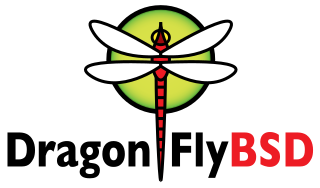
The GNU Debugger (GDB) is a portable debugger that runs on many Unix-like systems and works for many programming languages, including Ada, C, C++, Objective-C, Free Pascal, Fortran, Go, and partially others.
A virtual private network (VPN) is a mechanism for creating a secure connection between a computing device and a computer network, or between two networks, using an insecure communication medium such as the public Internet.

DragonFly BSD is a free and open-source Unix-like operating system forked from FreeBSD 4.8. Matthew Dillon, an Amiga developer in the late 1980s and early 1990s and FreeBSD developer between 1994 and 2003, began working on DragonFly BSD in June 2003 and announced it on the FreeBSD mailing lists on 16 July 2003.

Null modem is a communication method to directly connect two DTEs using an RS-232 serial cable. The name stems from the historical use of RS-232 cables to connect two teleprinter devices or two modems in order to communicate with one another; null modem communication refers to using a crossed-over RS-232 cable to connect the teleprinters directly to one another without the modems. It is also used to serially connect a computer to a printer, since both are DTE, and is known as a Printer Cable.
Direct Cable Connection (DCC) is a feature of Microsoft Windows that allows a computer to transfer and share files with another computer, via a connection using either the serial port, parallel port or the infrared port of each computer. It is well-suited for computers that do not have an ethernet adapter installed, although DCC in Windows XP can be configured to use one if available.

QEMU is a free and open-source emulator. It emulates the machine's processor through dynamic binary translation and provides a set of different hardware and device models for the machine, enabling it to run a variety of guest operating systems. It can interoperate with Kernel-based Virtual Machine (KVM) to run virtual machines at near-native speed. QEMU can also do emulation for user-level processes, allowing applications compiled for one architecture to run on another.
A terminal server connects devices with a serial port to a local area network (LAN). Products marketed as terminal servers can be very simple devices that do not offer any security functionality, such as data encryption and user authentication. The primary application scenario is to enable serial devices to access network server applications, or vice versa, where security of the data on the LAN is not generally an issue. There are also many terminal servers on the market that have highly advanced security functionality to ensure that only qualified personnel can access various servers and that any data that is transmitted across the LAN, or over the Internet, is encrypted. Usually, companies that need a terminal server with these advanced functions want to remotely control, monitor, diagnose and troubleshoot equipment over a telecommunications network.
In computer networking, TUN and TAP are kernel virtual network devices. Being network devices supported entirely in software, they differ from ordinary network devices which are backed by physical network adapters.
In the context of free and open-source software, proprietary software only available as a binary executable is referred to as a blob or binary blob. The term usually refers to a device driver module loaded into the kernel of an open-source operating system, and is sometimes also applied to code running outside the kernel, such as system firmware images, microcode updates, or userland programs. The term blob was first used in database management systems to describe a collection of binary data stored as a single entity.

Kernel-based Virtual Machine (KVM) is a free and open-source virtualization module in the Linux kernel that allows the kernel to function as a hypervisor. It was merged into the mainline Linux kernel in version 2.6.20, which was released on February 5, 2007. KVM requires a processor with hardware virtualization extensions, such as Intel VT or AMD-V. KVM has also been ported to other operating systems such as FreeBSD and illumos in the form of loadable kernel modules.
A kernel debugger is a debugger present in some operating system kernels to ease debugging and kernel development by the kernel developers. A kernel debugger might be a stub implementing low-level operations, with a full-blown debugger such as GNU Debugger (gdb), running on another machine, sending commands to the stub over a serial line or a network connection, or it might provide a command line that can be used directly on the machine being debugged.

The BeagleBoard is a low-power open-source single-board computer produced by Texas Instruments in association with Digi-Key and Newark element14. The BeagleBoard was also designed with open source software development in mind, and as a way of demonstrating the Texas Instrument's OMAP3530 system-on-a-chip. The board was developed by a small team of engineers as an educational board that could be used in colleges around the world to teach open source hardware and software capabilities. It is also sold to the public under the Creative Commons share-alike license. The board was designed using Cadence OrCAD for schematics and Cadence Allegro for PCB manufacturing; no simulation software was used.

The SheevaPlug is a "plug computer" designed to allow standard computing features in as small a space as possible. It was a small embedded Linux ARM computer without a display which can be considered an early predecessor to the subsequent Raspberry Pi.
ptrace is a system call found in Unix and several Unix-like operating systems. By using ptrace one process can control another, enabling the controller to inspect and manipulate the internal state of its target. ptrace is used by debuggers and other code-analysis tools, mostly as aids to software development.
The Remote Network Driver Interface Specification (RNDIS) is a Microsoft proprietary protocol used mostly on top of USB. It provides a virtual Ethernet link to most versions of the Windows, Linux, and FreeBSD operating systems. Multiple revisions of a partial RNDIS specification are available from Microsoft, but Windows implementations have been observed to issue requests not included in that specification, and to have undocumented constraints.
gdbserver is a computer program that makes it possible to remotely debug other programs. Running on the same system as the program to be debugged, it allows the GNU Debugger to connect from another system; that is, only the executable to be debugged needs to be resident on the target system ("target"), while the source code and a copy of the binary file to be debugged reside on the developer's local computer ("host"). The connection can be either TCP or a serial line.

IEEE 1394 is an interface standard for a serial bus for high-speed communications and isochronous real-time data transfer. It was developed in the late 1980s and early 1990s by Apple in cooperation with a number of companies, primarily Sony and Panasonic. Apple called the interface FireWire. It is also known by the brand names i.LINK (Sony), and Lynx.

Open vSwitch, sometimes abbreviated as OVS, is an open-source implementation of a distributed virtual multilayer switch. The main purpose of Open vSwitch is to provide a switching stack for hardware virtualization environments, while supporting multiple protocols and standards used in computer networks.
kdump is a feature of the Linux kernel that creates crash dumps in the event of a kernel crash. When triggered, kdump exports a memory image that can be analyzed for the purposes of debugging and determining the cause of a crash. The dumped image of main memory, exported as an Executable and Linkable Format (ELF) object, can be accessed either directly through /proc/vmcore during the handling of a kernel crash, or it can be automatically saved to a locally accessible file system, to a raw device, or to a remote system accessible over network.
A virtual kernel architecture (vkernel) is an operating system virtualisation paradigm where kernel code can be compiled to run in the user space, for example, to ease debugging of various kernel-level components, in addition to general-purpose virtualisation and compartmentalisation of system resources. It is used by DragonFly BSD in its vkernel implementation since DragonFly 1.7, having been first revealed in September 2006, and first released in the stable branch with DragonFly 1.8 in January 2007. The long-term goal, in addition to easing kernel development, is to make it easier to support internet-connected computer clusters without compromising local security. Similar concepts exist in other operating systems as well; in Linux, a similar virtualisation concept is known as user-mode Linux; whereas in NetBSD since the summer of 2007, it has been the initial focus of the rump kernel infrastructure.








